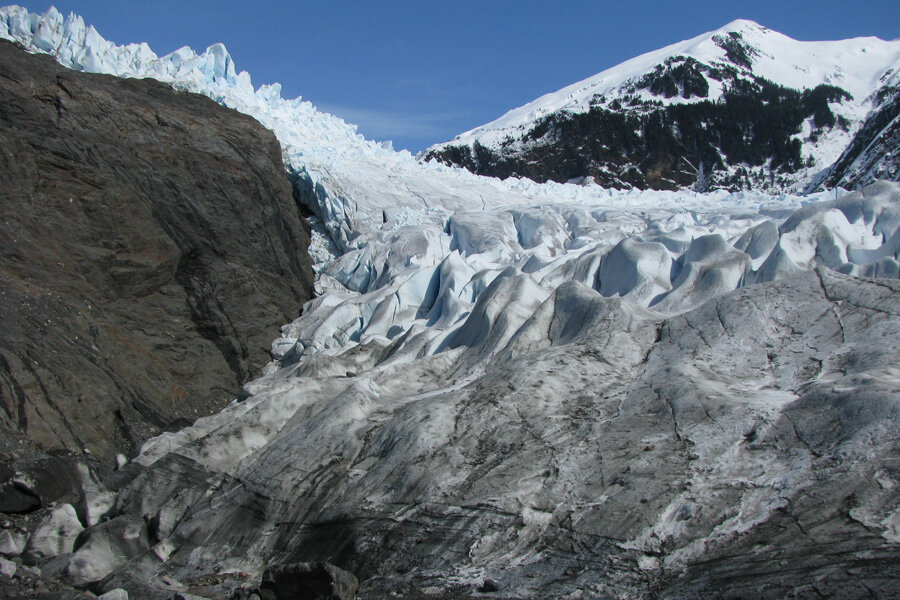Humans now the major cause of alpine glacier melt, researchers say
Loading...
Retreating alpine glaciers in a warming world may seem to have an obvious connection. But glaciers respond to environmental changes, well, glacially. At any point, it's hard to tell how much of a glacier's retreat is due to human-triggered factors now and how much is due to natural factors that might have held sway years ago, researchers say.
Now comes an analysis estimating that between 1990 and 2010, some 69 percent of the mass lost by the world's alpine glaciers can be traced to human influence – basically global warming. That compares with only 25 percent traceable to human influence averaged over the entire study period of 1850 to 2010. The team picked 1850 since that is when a prolonged, modest cooling period known as the Little Ice Age, mainly in the Northern Hemisphere, ended.
The study shows that throughout the 160-year period, an increasing proportion of mass loss could be traced to human influence, which becomes significant from about 1950 on, notes Ben Marzeion, a researcher at the Institute of Meteorology and Geophysics at the University of Innsbruck in Austria who led the team performing the analysis.
The behavior of glaciers as the climate warms is of keen interest, since they serve as icy reservoirs of vital fresh water for hundreds of millions of people during the peak melt season.
Up to 119 million people rely on glaciers for 50 percent of their fresh water during peak melting, while 317 million rely on the melt water for at least 10 percent of their supply, according to an analysis published two years ago by researchers at the University of Washington in Seattle and the US Department of Energy's Pacific Northwest National Laboratory in Richland, Wash. More than 90 percent of the people who rely to some extent on glacial melt to water crops or serve cities live in Asia.
In addition, the glacial retreats can set up conditions for disastrous floods as melt water builds up behind unstable natural dams formed from the rock and sediment the retreating glaciers leave behind.
While the link between retreating glaciers and human-triggered global warming has become a given, the team was unaware of any other study performing the kind of formal attribution analysis that other aspects of global warming, or global warming itself, have undergone, notes Marzeion in an e-mail.
Indeed the human fingerprint was readily detectable, more so than Marzeion had anticipated, he writes.
As with many aspects of climate change, not all glaciers are equally affected. Indeed, the human influence that is clear in the aggregate becomes much harder to tease out on a region-by-region basis, he and his colleagues acknowledge. This reflects the increasing uncertainty in results that global climate models produced as researchers try to drill deeper into regional details. Natural variability in glaciers often is much more evident than human influences on regional scales, whereas the human influence is more evident in global averages.
Human influence was detected with high confidence in places such as Alaska, western Canada, the US, Greenland (its ice sheet was omitted for this study), Central Europe, and New Zealand. The picture was less clear in Iceland, Scandinavia, northern Central Asia, and the Russian Arctic.
"Glaciers are mostly in mountain regions, which are notoriously difficult for climate models to get right," notes Marzeion.
Despite those difficulties, however, the detection of human influence was so clear in the aggregate that it "tells a bit about how strong the anthropogenic signal is."
The team used a sophisticated glacier-simulation model that estimates changes in mass for each of more than 122,000 glaciers worldwide, based on changing climate conditions. When the model is fed with climate data measured in the real world, it reproduces changes in glacier mass comparable to the changes researchers see as they gather field measurements over time.
The team then used repeated runs of global climate models the Intergovernmental Panel on Climate Change used for its recent Fifth Assessment Report on global warming to reconstruct Earth's climate between 1850 and 2012. All of the runs included natural influences on climate – changes in solar radiation, or volcanic eruptions for instance. But only half of the runs included greenhouse gases humans have introduced through burning fossil fuel and through land-use changes. The two separate groups of results provided a natural evolution of climate over the entire period and a climate whose evolution has been influenced by humans.
The team applied each of these two climates to each of the glaciers individually, beginning with 1851, then ran the glacier model to see how the glaciers evolved with and without the additional greenhouse gases. Throughout the period, glaciers persistently lost mass under both scenarios. But by about 1960, the modeled losses in a global-warming world fell into lockstep with the losses researchers have recorded in the field.





